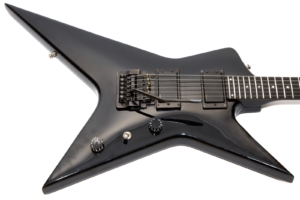
Sadly, my wife had thrown all my stretchy neon out years ago so I had to settle for a technical review devoid of any photos of me trying to reclaim my day-glo youth in style. I’m sure your disappointment is profound.
Let’s see how this, one of the pointiest of guitars of all time, holds up to the critical observations of someone who lived through the time when guitars like this were more popular in hot pink.
Introduction
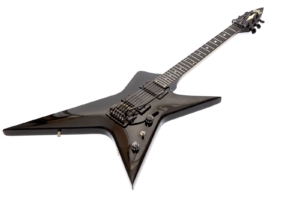
The entire scene was replete with hairspray, neon colors, men wearing makeup and woman’s lingerie over spandex, and guitars so pointy that they often distracted some of us from the fact that we were watching men wearing women’s underwear on stage while wishing we could be them. What’s crazier is that it all worked! Guys loved them, girls loved them, and the the guys loved the girls loving them. Also there was a lot of drugs.
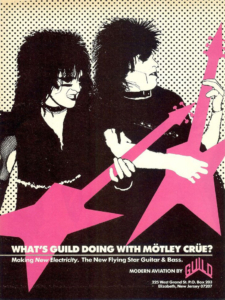
Did I mention all the drugs?
The X-88 Flying Star came stock with only one California pickup and could be ordered with a pile of options including one or two Dimarzio or EMG pickups (or single coils and humbucker, etc.), various colors, and a Kahler floating bridge. Following the price guide, the guitar in this review is technically an X-88AK3 since it’s an X-88 (duh), has two EMG humbuckers (A2), and a Kahler. The list price of this guitar would have been $990 ($660 base + $200 Kahler + $190 for two EMGs). The case (model 4580) would have been $145 and would have been worth every penny as I’ll soon explain.
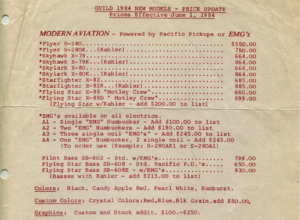
The second thing that cracks me up about the price list is that the X-88 is listed as the Flying Star X-88 “Motley Crew” with a notable absence of umlauts no doubt due to the lack of such features on the IBM Selectric typewriter they probably used to type the list. The kicker, and perhaps my favorite error, is the fact that it lists the X-88 model as the Motley Crew and not Motley Crue. I mean, it’s not like spell-check auto-corrected it for them. It is in quotes, though, so maybe it all makes sense.
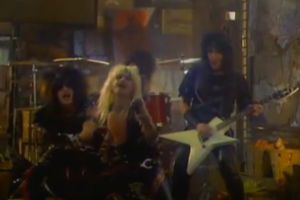
A white single-pickup version of one of these dangerously pointy guitars can be seen in the Mötley Crüe video Too Young to Fall In Love as the screen cap above shows. Oh, and if you somehow didn’t believe me about the glorious cheese-fest that was the ’80s, go watch that video. It’s got amazing martial arts sequences where four scrawny alcoholic heroin junkies defeat various kung fu warriors. No suspension of disbelief required.
And we all thought it was so cool!
The “Plug into New Electricity” flyer to the right shows three Guild X-88Ks (K for Kahler) in various colors, the most suble of which being cocaine white (I’m pretty sure that’s not the real name). The color second from the right is what I like to call, “Holy crap, were the ’80s really that crazy?” burst. The the one on the right is generally called pink. Maybe hot pink. I don’t know, the colors all kind of make me dizzy now. Oh, and the white is indeed called cocaine pearl white.
As someone who remembers 1984 (Van Halen!) with the hazy fondness of someone who also can’t seem to accept the fact that it was 33 years ago, I was very eager to wrap my hands around this bit of ’80s history and crank up the Marshalls. OK, I use an Axe-FX II XL+ for my amp needs these days, but that still works because rack-hounds first became a thing in the ’80s. Also, the only Marshall I currently own is a Class 5 and that just seemed lame even though it’s totally not.
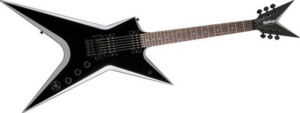
The Case
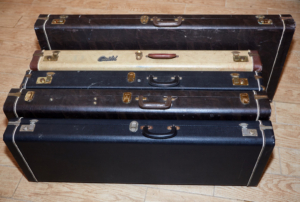
The pic to the right shows five guitar cases. The guitars they are holding, from front to back, are as follows: Guild S60, Guild S270, Guild S300, Guild S70, and the Guild X-88 that is the subject of this review. And yes, I have a lot of Guilds.
As you can see it’s a full four inches wider and taller than the largest of the other cases, and it’s a half inch thinner as well. All of this adds up to a case that’s likely to fall over when standing alone and because the case is to long thin and heavy, the handle flexes the entire top when used. In short, the case is a pain in the ass. The size of the case becomes a concern when buying or selling one of these guitars, too, because the case will not fit in a normal guitar box from Taylor, Gibson, or Martin, so you’ll probably end up paying more for shipping prep if you don’t do it yourself.
Now, the case by itself is one thing, but the one I got is in rough shape so I’d like to get a replacement. This guitar ain’t fitting in no Les Paul case! It doesn’t fit into any case I have, it doesn’t fit into any gig bag I have, and it really needs a case because of all those dangerous points. I will admit that it looks pretty killer hanging on the wall, though. Also, abandon all hope of this sitting on a traditional guitar stand unless you’d eventually like to see it fall on the floor.
Finish
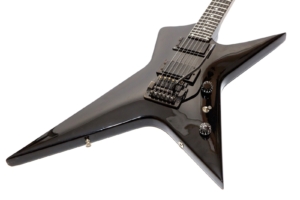
The quality of the finish is pretty good, but all of these pointy guitars are a mess at the points, and this guitar is no exception. I imagine it would be hard to protect those points, and on this guitar as you’ll soon see, it’s very long, kind of unweildy, and is prone to being smashed into everything in a three-foot radius around the player, even when the player is sober.
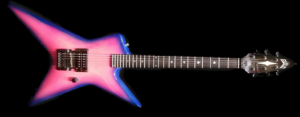
Fretboard and Neck
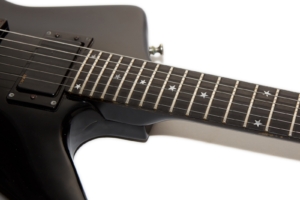
The fretboard is unbound ebony and the inlays are all stars, probably because the guitar is called the X-88 Flying Star and Mick Mars liked it that way. The radius of the fretboard measured at 9.5″ on my Stew Mack radius gauges. I know Mick Mars likes Strats, so it’s no surprise that the fretboard would have a very Strat-like curve to it.
The width at the nut is 1 21/32″ which is halfway between 1 5/8″ and 1 11/16″. The neck has a nice feel to it with a typical Guild medium C shape and a reasonably good depth that progresses up the fretboard as expected.
This guitar has seen some action, and the edges of the fretboard are worn and the finish seems to be either chipped away or sort of bubbling in spots, though that’s not really noticeable while playing. With its 9.5″ radius, the guitar is easy to chord and thanks to the good setup, doesn’t fret out on high notes while bending.
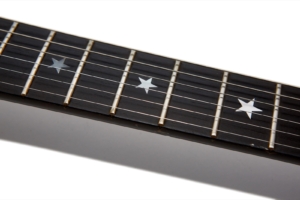
The neck is straight as it has been on almost every Guild electric I’ve ever owned, and as a result the action can be set nice and low or a bit higher as desired.
Build Quality
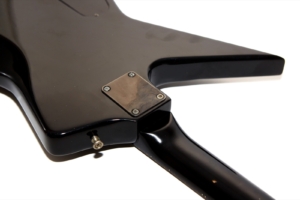
This guitar weighs nine pounds one ounce with the Kahler arm and battery installed which further adds credence to the body being mahogany. It also adds one more negative to the overall package; it’s not only unwieldy, it’s also fairly heavy. Because the body is so large and heavy, the center of gravity is around the pickups which means you can’t really hold the guitar by the neck joint unless it’s vertical. That’s not a deal breaker, but it seems odd especially given the balance issues while wearing a strap (more on that later).
The guitar is solid and well made and there are no feelings of “cheapness” anywhere on the guitar. The locking nut machine screws are a bit rusted but that’s common on an almost 30 year old guitar.
I’m not a big fan of bolt-on necks, but the joint is solid and I have no complaints about it. Other Guilds I’ve had with bolt-on necks use wood screws to join the two pieces, and I try not to remove necks with wood screws unless it’s absolutely necessary since I think it’s a bad idea to disturb the thread channels in the wood. For that reason I left this one alone.
Pickups
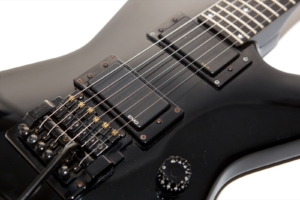
I was never a fan of EMGs until recently. When I started writing these reviews I had my Axe-FX system that let me sample many amp types, and that allowed me to appreciate the EMGs in a way that I couldn’t previously. Although I’m still not a fan of having batteries in guitars, especially when there isn’t a dedicated battery compartment, I think the EMGs are great for high-gain situations where power and articulation is more important than character.
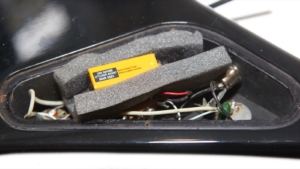
Electronics
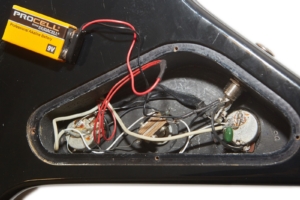
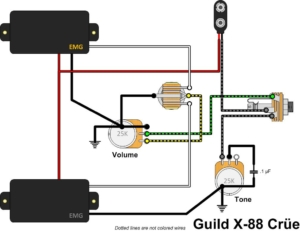
Secondly, each pickup is grounded to one of the pots. I don’t think this is particularly important, but if you look the signal wire from each of the pickups goes directly to the pickup selector switch. Normally I see the pickups go to the volume pots and then to the selector switch, but because this is a master tone/volume setup, the pots are after the selector switch in the circuit.
None of these variations really matter from the AC circuit standpoint, but they’re different than what I normally see when I tear open a guitar so I figured pointing them out might help someone trying to restore one of these guitars to the original design.
Hardware
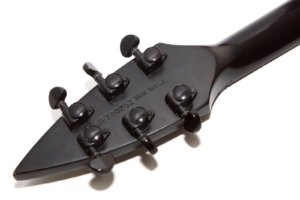
The Kahler is the same 2300 Pro model found on most of the ’80s Guild shredders I’ve reviewed. It functions quite well with the only downside being the infuriating locking nut and the tendency for the fine tuning knobs to turn while palm muting.
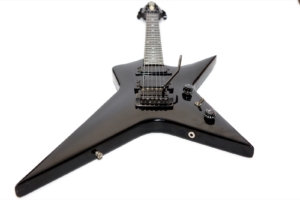
The knobs on this guitar are Guild speed knobs, and they may very well be original, though I’d have preferred the knurled metal knobs found on other Guild shredders.
The switch tip is the fantastic Guild metal switch tip that can be all but impossible to replace, so that was a nice surprise because given the wear on the case I would have expected the switch tip to be long lost by now.
With the exception of the placement of the strap pegs, the hardware is pretty standard for a Guild from 1984.
Sound
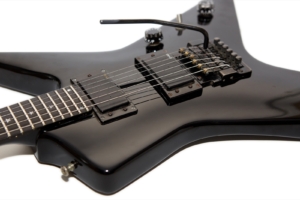
Too Young
Looks Could Kill
Kick Start
The setup for these recordings is my Axe-FX II XL+ direct into my Macbook Pro via USB. Thankfully, I’ve figured out all the drops issues (CPU utilization both on the AXE-FX and the Mac) and now get some pretty clean recordings.
The recordings are my terrible renditions of Too Young to Fall in Love, followed by If Looks Could Kill, and finally followed up by Kick Start my Heart. The amps settings on the first two are a Mötley Crüe custom patch that I download from the Fractal Axe-Change site. The last one is a default patch called “Thick and Chunky” which is basically a vintage Mesa Recto-Verb. All three recordings are the bridge pickup.
Playability
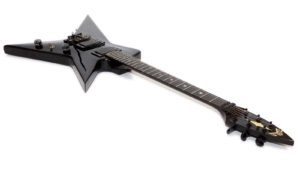
I love goofy pointy ’80s guitars, but even I have to admit that this guitar is kind of ridiculous. Why? First off, it hangs funny when standing. The guitar swings from the strap due to its shape and because both of the strap pegs are above the centerline of the guitar. That means that the guitar kind of swings like a pendulum which is exacerbated when using the Kahler.
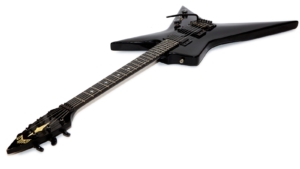
The X-88 is slightly neck-heavy enough that when I play with one of my smooth El Dorado straps the guitar will slide on my shoulder and do the headstock dive thing. I learned to lean my elbow on the giant tail-fin on the back which counter-balanced the guitar. A more abrasive strap would probably keep it more steady, but it would not solve the problem of the guitar swinging due to the strap pegs being so high above the midline of the instrument. I find this odd because of the fact that when being held by the neck joint, the guitar appears to be very body-heavy.
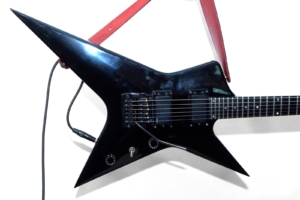
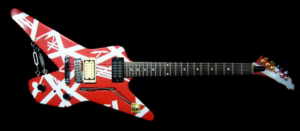
Conclusion
I really like this guitar. On paper.
In practice, though, the guitar is kind of a pain in the ass. It’s huge, it’s heavy (but not Norlin-era Les Paul Custom heavy), the giant point on the back slams into things all the time, the long pointy headstock slams into things all the time, it swings like a pendulum on a strap, the neck feels like it’s a mile long, and the swinging pendulum thing makes the Kahler more difficult to use. Oh yeah, and the case sucks and is practically impossible to replace.
However…
This guitar is fun. When you strap it on you feel like ripping into some fingertapping hair metal and you feel like making it loud. The problem is that it’s fun for a while, kind of like playing with a two year old; they’re fun to play with until they’re not at which point I want to hand it back to the owner because I just remembered that I’m not 25 anymore.
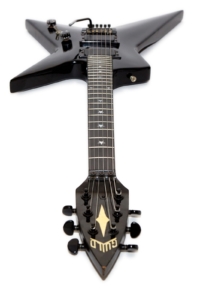
Having written that, the guitar is currently hanging on my office wall because it’s so unique. It is most definitely an attention grabber and conversation starter and people who aren’t even into guitars ask me about it. Oh, and don’t worry, I play my wall hangers and I can prove it by the dent in my ceiling that the pointy headstock put there from taking it down repeatedly.
Of course, if you know anything about Mötley Crüe then you know their whole schtick was being over the top in every way. If that’s your thing, then this is the guitar for you and nothing I could write would matter, anyway.
Donate: PayPal Crypto:
ETH: 0x0AC57f8e0A49dc06Ed4f7926d169342ec4FCd461
Doge: DFWpLqMr6QF67t4wRzvTtNd8UDwjGTQBGs

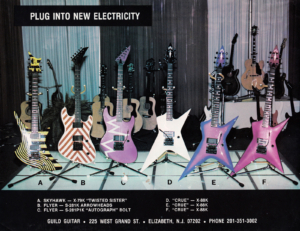

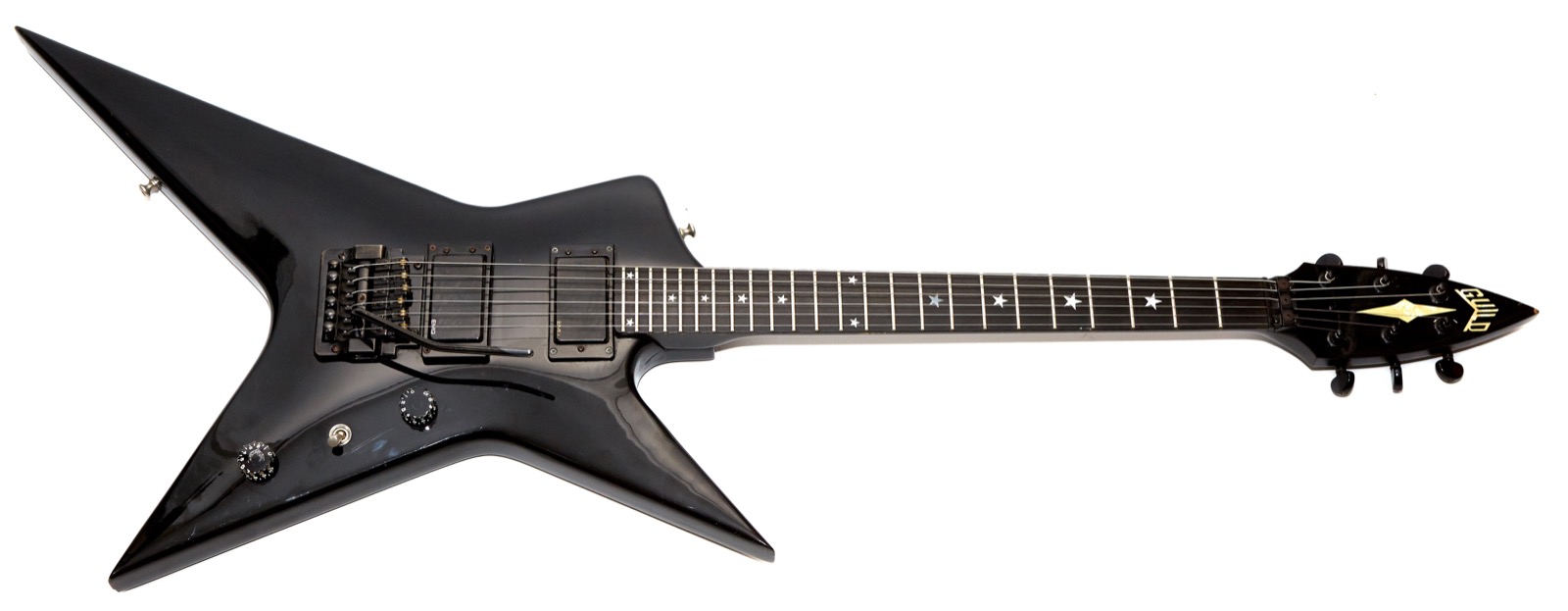
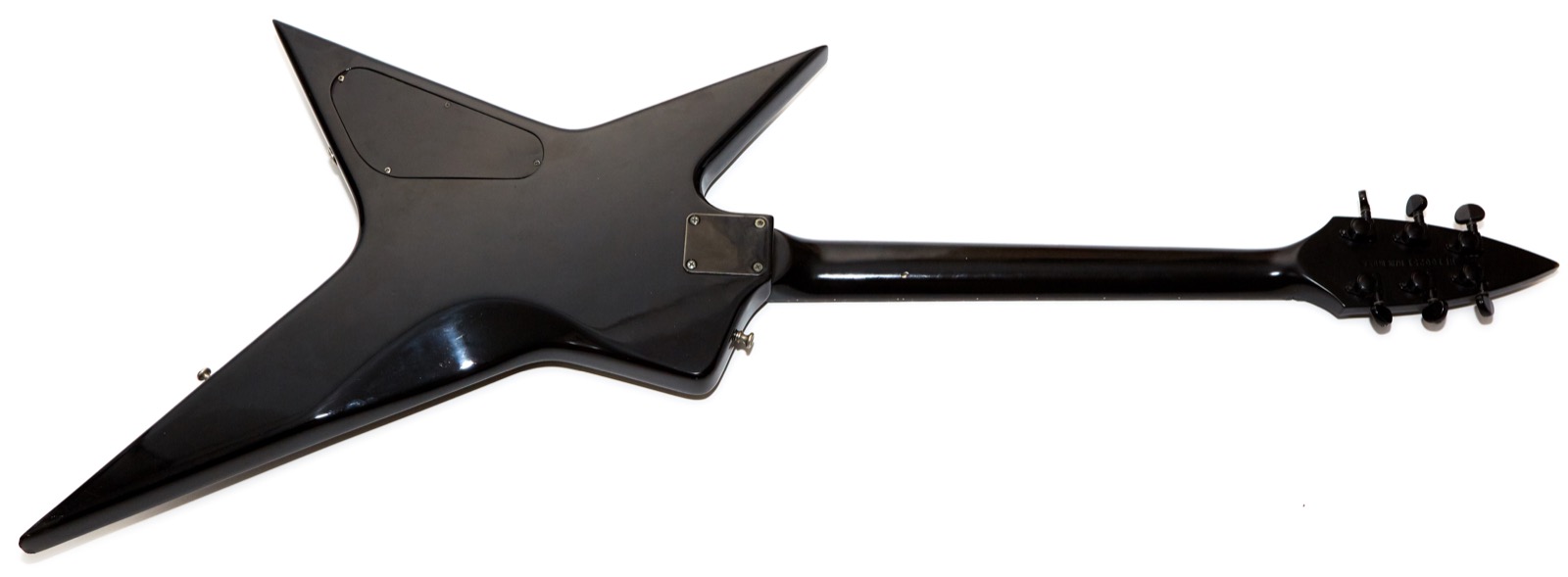
Hey, hows it going? I just got the hot pink x88 with the black kahler and active emg! Theres not a scratch on it! A [girl] had it and kept it in the case for many years! I think the original strings were on ot because they were black and corroted! Anyway it plays like butter and ot sounds killer through the marshall!! This gpes great with my collecton of the old bc rich bich and mockingbird!
By the way, how many of the hot pink ones were made?
Hot pink are the most common. No one wanted them then and no one really wants hot pink now. Thus they are cheaper. The black and white are less common and get more money. Usually they are chipping at the points. Those that arent get more money.
I have a black single pickup model in immaculate condition I have owned for about 20 years now ,this thing screams /I dont play it much as the strat is a bit more comfy
Hi. I want to let you know that I have a case for sale on EBay. In your write-up, you mentioned that you would like a new case. Anyhow, just want to make you aware.
Mark
Here’s a link
https://rover.ebay.com/rover/0/0/0?mpre=https%3A%2F%2Fwww.ebay.com%2Fulk%2Fitm%2F153189984620
Thanks. Sold the guitar a while back and managed to find the buyer a new case as well about six months back. Yours would have been a most welcome post if not for the passage of time. Hopefully this will help someone else find one as they are not easy to find.
I recently added one of these to my collection. It has the inline 6 headstock. I’ve read that this would mean it was made in ‘85. The white, pink and black ones have been the only ones I’ve seen online. Mine is blue. Do you have any idea how many blue ones were made?
Sorry no idea. I’d love to see pics, though.
I bought an X88 back in 1984-85? It was about 750.00 I believe. Wish I still had it. It was black/white zebra striped from the factory, and no one seems to recall them ever being made in that color scheme. Had the Kahler and two humbuckers. I’ve been searching for years to see if it still exists and would love it acquire it back, as it was my first real guitar as a teen and has sentiment. I had regrettedly traded it in for some other gear around 1987-88 or so at East Coast Music in Danbury, CT if anyone knows of it’s whereabouts. Clearviewmusic@aol.com
I have a white X88D with a Kahler and 2 Dimarzio humbuckers. Bought it new in 1984 for $750 at The Music Nook in Milford MA. Minor knicks on tips. I didnt even have a drivers license at the time so had to take a cab to go buy it! I wonder how much it’s worth now..